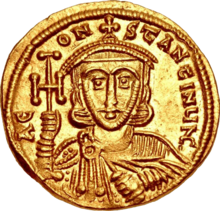
Back Konstantyn V van Bisantium Afrikaans Konstantin V. (Byzanz) ALS Constantín V AN قسطنطين الخامس Arabic قسطنطين الخامس ARZ Constantín V AST V Konstantin (imperator) Azerbaijani بئشینجی کونستانتین AZB Константин V Копроним Bulgarian Konstantin V Kopronim BS
| Constantine V | |
|---|---|
| Emperor of the Romans | |
 Solidus of Constantine V. | |
| Byzantine emperor | |
| Reign | 18 June 741 – 14 September 775 |
| Coronation | 31 March 720[1] |
| Predecessor | Leo III the Isaurian |
| Successor | Leo IV the Khazar |
| Rival emperors | Artabasdos (741–43) Nikephoros (741–43) |
| Born | July 718[2] Constantinople (now Istanbul, Turkey) |
| Died | 14 September 775 (aged 57) |
| Wives | |
| Issue | Leo IV Nikephoros Christopher Niketas Eudokimos Anthimos Anthousa |
| Dynasty | Isaurian |
| Father | Leo III the Isaurian |
| Mother | Maria |
| Religion | Chalcedonian Christianity |
Constantine V (Greek: Κωνσταντῖνος, translit. Kōnstantīnos; Latin: Constantinus; July 718 – 14 September 775) was Byzantine emperor from 741 to 775. His reign saw a consolidation of Byzantine security from external threats. As an able military leader, Constantine took advantage of civil war in the Muslim world to make limited offensives on the Arab frontier. With this eastern frontier secure, he undertook repeated campaigns against the Bulgars in the Balkans. His military activity, and policy of settling Christian populations from the Arab frontier in Thrace, made Byzantium's hold on its Balkan territories more secure. He was also responsible for important military and administrative innovations and reforms.
Religious strife and controversy was a prominent feature of his reign. His fervent support of Iconoclasm and opposition to monasticism led to his vilification by some contemporary commentators and the majority of later Byzantine writers, who denigrated him with the nicknames "Dung-Named" (Greek: Κοπρώνυμος, translit. Koprónimos; Latin: Copronymus), because he allegedly defaecated during his baptism,[3][1] similarly "Anointed with Urine" (Greek: Οὐραλύφιος, translit. Ouralýphios; Latin: Uralyphius),[4] and "the Equestrian" (Greek: Καβαλλινος, translit. Kaballinos; Latin: Caballinus), referencing the excrement of horses.[3][5]
- ^ a b PBE (2001) Konstantinos 7 (#3703)
- ^ Nikephoros 1990, p. 125 (chapter 56).
- ^ a b Cholij, Roman (2002). Theodore the Stoudite: The Ordering of Holiness. Oxford University Press. p. 12. ISBN 9780199248469.
- ^ Lampte, G.W.H. (1961). A Patristic Greek Lexicon. Oxford at Clarendon Press. pp. 977, after Theodore the Studite.
- ^ Bury, J.B. (1889). A History of the Later Roman Empire from Arcadius to Irene (395 A.D. to 800 A.D.). p. 462. ISBN 978-1-4021-8368-3.
© MMXXIII Rich X Search. We shall prevail. All rights reserved. Rich X Search